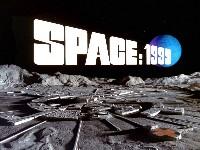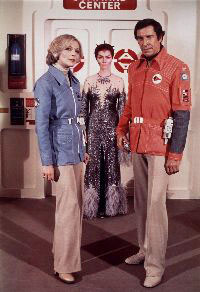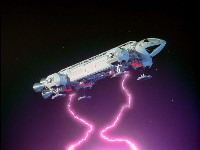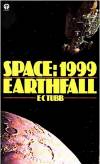| The series |

Space: 1999 was a television science fiction series originally aired in 1975-1978.
It was created and produced by Gerry and Sylvia Anderson, who were well known for their popular puppet science fiction series in the 1960s such as Thunderbirds and Stingray.
Read about Gerry Anderson productions
There were 2 series, each of 24 one hour episodes. The two series, referred to as Year One and Year Two, were radically different. A new producer, Fred Freiberger, took over for Year Two and introduced a new leading character, new sets, costumes, music and more fantasy based stories.
Read the behind the scenes story in the Production Guide
Read how the show was marketed throughout the world
Read transcripts of every episode
Read a comprehensive guide to the episodes
In the 1980s, ITC produced four movies, each compiled from two episodes. The first two movies were made in London on film with minimal cuts and some additional scenes; the second two were made in the US on videotape with ruthless cutting.
Read a comprehensive guide to the movies
Read more details of the movies
Read the transcripts and credits of each movie
|
| The premise |
There are 300 men and women on a base on the Moon, Moonbase Alpha.
In 1999, stored nuclear waste on the Moon explodes, sending the Moon out of orbit. On a random course through deep space, the Moon and the crew of Alpha encounter aliens and strange worlds.
In Year Two, Maya, an alien who can transform into other animals, joins them.
Read guides to the series
Read a detailed description of the series continuity
|
| The cast |

Martin Landau, from Mission: Impossible, played Commander John Koenig.
His wife, Barbara Bain, played Dr Helena Russell.
In Year One, Barry Morse, from the Fugitive, played scientist Professor Bergman.
In Year Two, Catherine Schell, from Return Of The Pink Panther, played alien Maya.
Chief among the supporting cast were Nick Tate as pilot Alan Carter and, in Year Two only, Tony Anholt as second in command Tony Verdeschi.
Guest cast included Christopher Lee, Margaret Leighton, Roy Dotrice, Peter Cushing, Joan Collins, Ian McShane, Brian Blessed, Judy Geeson, Leo McKern, Jeremy Kemp, Lisa Harrow, Peter Bowles, Patrick Troughton, Freddie Jones and Billie Whitelaw.
Read character profiles
Read original cast and crew credits
|
| Visuals |

The special effects were universally acclaimed and served as a benchmark for Star Wars (Brian Johnson, special effects director, went on to work on Alien and The Empire Strikes Back, earning Oscars for both). The Moonbase spaceship, called the Eagle, is one of the classics of science fiction design.
Read special effects crew credits
Read articles in the Reference Library
The production design, by Emmy award winning Keith Wilson, was also admired.
Read Keith Wilson profile
Pre-production art in the Reference Library
|
| Critics and Fans |
Critics were scathing about the scripts and acting. Isaac Asimov also strongly criticised the science.
Read a detailed analysis of the science
Read the critics section of the reference library
The show has a devoted fan following. Most prefer the more serious Year One episodes; some strongly dislike Year Two, although it has supporters.
Read about fan clubs
Read about fan conventions
Read a list of links to other Internet sites
|
| Merchandise |

Vintage merchandise is very popular, and new items are still being produced, including Eagle models, books and DVDs.
Read the merchandise guide including full listings, illustrations and currently available lists.
|
| New Movies, New Series, DVD |
For a while, Polygram owned the movie rights to Space: 1999 (although the series is owned by ITV plc). Polygram developed Gerry Anderson's previous series, Thunderbirds, as a movie and in 1998 had preliminary discussions with Nick Tate and Brian Johnson about a Space: 1999 movie. The rights have now reverted to ITV. Several revivals have been pitched to ITV over the years, but the cost is likely to be high and the updates would probably make it radically different to the original.
Read a guide to Space: 2099
Since 2001, the entire series has become available on DVD in many countries, including the UK, USA, France, Germany, Japan, Portugal, Spain, Italy and Australia.
In 2005 the UK company Network released a remastered version of Year 1 on DVD. This is generally far superior to the previous versions.
At the same time as the new DVD masters were made, new HD versions of the episodes were made. There are two versions: one is 4:3 (original picture ratio), the other is 16:9 (widescreen, with top and bottom of the picture cropped). These were shown on the UK channel ITV HD during trial transmissions in 2006. Year 1 was released on Blu-ray in 2010. Year 2 was released on Blu-ray in 2015.
DVD comparison.
Latest DVD news.
HD vs DVD comparison
A new short film "Message From Moonbase Alpha" was shown on September 13th 1999. This described events 20 years after the original series. It is available on the French and US DVD sets.
Read an episode guide to Message From Moonbase Alpha.
You can watch all episodes on various streaming platforms- in the UK, on Britbox, in the US on Tubi, and equivalent services in most other countries.
|
| Common Questions |
- What happened to Victor Bergman in Year 2?
- A scene cut from The Metamorph explains it. The character profile describes how the Powys books returned him.
Actor Barry Morse later claimed "I'd rather play with the grown-ups for a while" (1982 source). In fact Anderson offered him less money, and Morse tried to negotiate a higher offer. No agreement was reached. Producer Freiberger wanted a younger cast, and disliked his character ("I felt his part was all wrong", source).
- Why was the second series so different?
- The first series had some strong ratings, but was sold in syndication, not to the US networks (see details). ITC was reluctant to fund a second series on the same basis, until Gerry Anderson recruited American writer-producer Fred Freiberger who proposed big changes to appeal to US audiences. The primary goal was a US network sale.
- Was the budget cut in Year 2?
- The budget was raised from $6.5 million to $7.2 million (just under 11% increase). However, UK inflation was about 25% in 1975, so it was a real-terms cut. The major cost-cutting was reducing the production schedule, from 15 months for year 1 to 11 months for year 2.
- Was Fred Freiberger the show killer?
- Producer Freiberger certainly revamped the show's format for Year 2, but ultimately delivered the series on-schedule.
The first series was wildly behind schedule (15 months instead of 11). The original broadcast date was planned for September 1974 (it was not shown until a year later). It was made on the assumption it would be sold to a US network (just before filming, CBS dropped the series in favour of their own Planet of the Apes series, see here). ITC had wanted more American writers who would know what US audiences would respond to; after that process failed in Year 1, they would demand an experienced American show-runner for any second series. After Year 1 finished, the cast and crew had to find other jobs for 9 or 10 months before Year 2 was approved and preparations began (in December 1975). Year 2 would not have been approved without changes, and an American producer.
Finally, it is worth noting that the cast and crew made The Day After Tomorrow: Into Infinity after year 1 and long before Freiberger was contacted, which arguably showed many of the directions that Year 2 would take, in sets, plot and music.
- How many Eagles crashed or exploded?
- Full list here
- Can I buy an Eagle?
- Round 2 have done several model kits: 14 inch and the 22 inch are excellent. Sixteen 12 have done Eagles in different scales too. If you want an original SFX model, one model sold for £125,000/$153,000 in 2021.
- In Last Sunset they open a window on Moonbase!
- In the episode that window is blown out by an alien capsule giving air to the Moon. Now the Moon has an atmosphere, it makes sense they would replace it with an opening window. A scene was filmed which made this more explicit, but was cut. So, not really an error.
- Was Breakaway originally a 90 minute episode?
- It was always intended to be an hour-long episode, but it did take an exceptionally long time to film (26 days, instead of the standard 11). There were many cut and re-shot scenes, and the initial editor's cut was reportedly too long (but not necessarily 90 minutes). This was not unusual. Several other episodes also had problems with the initial edit, and had new scenes filmed (Missing Link, The Last Enemy, Space Brain). It is possible the director was trying to make a version of the episode that could be extended into a film, but it is difficult to see what could make it much longer than 52 minutes. The script and filmed scenes did not have 90 minutes of material.
- Was Space: 1999 cancelled so Lew Grade could make Raise The Titanic and other movies?
- No (but Martin Landau suggested it in a 1986 interview). Lew Grade was already making movies before and after Space 1999; some were huge hits. Raise The Titanic didn't start filming until 1979. Grade continued to make TV series after Space: 1999 (The Muppet Show, Jesus of Nazareth).
|



